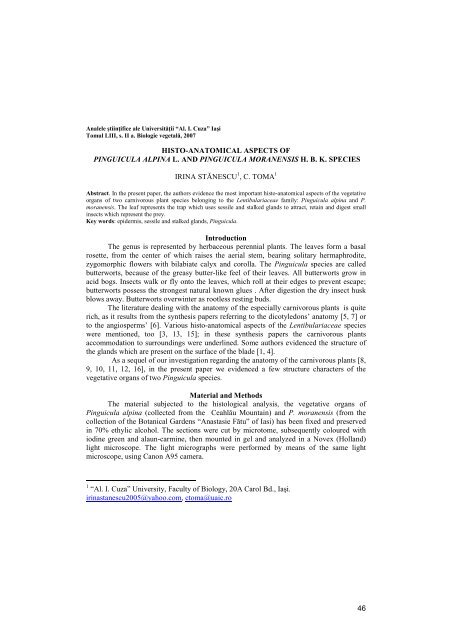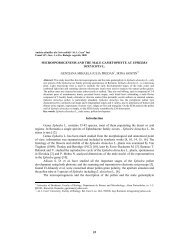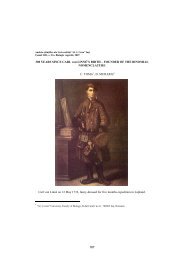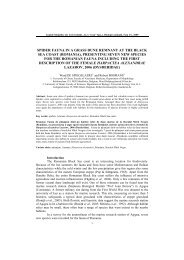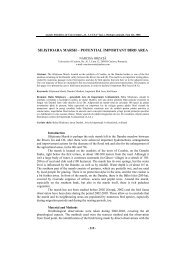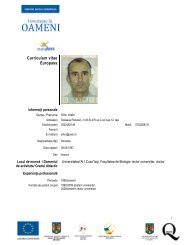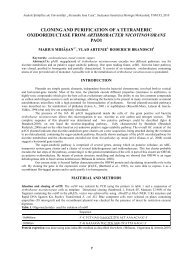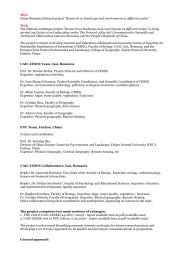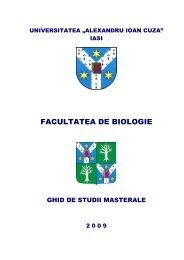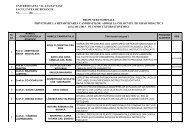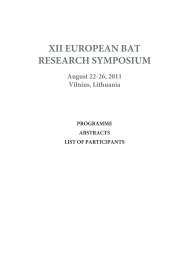ANALELE UAIC, Biol. Veg. - Facultatea de Biologie
ANALELE UAIC, Biol. Veg. - Facultatea de Biologie
ANALELE UAIC, Biol. Veg. - Facultatea de Biologie
Create successful ePaper yourself
Turn your PDF publications into a flip-book with our unique Google optimized e-Paper software.
Analele ştiinţifice ale Universităţii “Al. I. Cuza” Iaşi<br />
Tomul LIII, s. II a. <strong>Biol</strong>ogie vegetală, 2007<br />
HISTO-ANATOMICAL ASPECTS OF<br />
PINGUICULA ALPINA L. AND PINGUICULA MORANENSIS H. B. K. SPECIES<br />
IRINA STĂNESCU 1 , C. TOMA 1<br />
Abstract. In the present paper, the authors evi<strong>de</strong>nce the most important histo-anatomical aspects of the vegetative<br />
organs of two carnivorous plant species belonging to the Lentibulariaceae family: Pinguicula alpina and P.<br />
moranensis. The leaf represents the trap which uses sessile and stalked glands to attract, retain and digest small<br />
insects which represent the prey.<br />
Key words: epi<strong>de</strong>rmis, sessile and stalked glands, Pinguicula.<br />
Introduction<br />
The genus is represented by herbaceous perennial plants. The leaves form a basal<br />
rosette, from the center of which raises the aerial stem, bearing solitary hermaphrodite,<br />
zygomorphic flowers with bilabiate calyx and corolla. The Pinguicula species are called<br />
butterworts, because of the greasy butter-like feel of their leaves. All butterworts grow in<br />
acid bogs. Insects walk or fly onto the leaves, which roll at their edges to prevent escape;<br />
butterworts possess the strongest natural known glues . After digestion the dry insect husk<br />
blows away. Butterworts overwinter as rootless resting buds.<br />
The literature <strong>de</strong>aling with the anatomy of the especially carnivorous plants is quite<br />
rich, as it results from the synthesis papers referring to the dicotyledons’ anatomy [5, 7] or<br />
to the angiosperms’ [6]. Various histo-anatomical aspects of the Lentibulariaceae species<br />
were mentioned, too [3, 13, 15]; in these synthesis papers the carnivorous plants<br />
accommodation to surroundings were un<strong>de</strong>rlined. Some authors evi<strong>de</strong>nced the structure of<br />
the glands which are present on the surface of the bla<strong>de</strong> [1, 4].<br />
As a sequel of our investigation regarding the anatomy of the carnivorous plants [8,<br />
9, 10, 11, 12, 16], in the present paper we evi<strong>de</strong>nced a few structure characters of the<br />
vegetative organs of two Pinguicula species.<br />
Material and Methods<br />
The material subjected to the histological analysis, the vegetative organs of<br />
Pinguicula alpina (collected from the Ceahlău Mountain) and P. moranensis (from the<br />
collection of the Botanical Gar<strong>de</strong>ns “Anastasie Fătu” of Iasi) has been fixed and preserved<br />
in 70% ethylic alcohol. The sections were cut by microtome, subsequently coloured with<br />
iodine green and alaun-carmine, then mounted in gel and analyzed in a Novex (Holland)<br />
light microscope. The light micrographs were performed by means of the same light<br />
microscope, using Canon A95 camera.<br />
1 “Al. I. Cuza” University, Faculty of <strong>Biol</strong>ogy, 20A Carol Bd., Iaşi.<br />
irinastanescu2005@yahoo.com, ctoma@uaic.ro<br />
46
Results and Discussion<br />
The root<br />
The root has a primary structure, with the typical anatomical zones: rhizo<strong>de</strong>rmis,<br />
cortical parenchyma and central cylin<strong>de</strong>r. The rhizo<strong>de</strong>rmis consists of small cells, with<br />
thick walls; rarely ,can we see root hairs. The cortical parenchyma is thick, homogenous<br />
and meatus type (7-8 layers in P. alpina, 5-6 in P. moranensis), having large cells; its most<br />
internal layer, a primary type endo<strong>de</strong>rmis, shows Casparian thickenings in the radially walls<br />
of the cells. The central cylin<strong>de</strong>r is thin, with a one-layered pericycle, 4 in P. alpina (Fig.<br />
1), 6 in P. moranensis xylem bundles which alternate with the same number of phloem<br />
bundles. The xylem bundles have few (1-2) vessels with little thickened and little lignified<br />
walls. The phloem bundles form small isles with sieved tubes and companion cells. In the<br />
central part of the root there is parenchymatous, meatus type pith.<br />
The rhizome<br />
The epi<strong>de</strong>rmis is exfoliated in P. alpina, while in P. moranensis it persists and<br />
consists of tangentially-elongated cells. The rhizome has a thick cortical parenchyma,<br />
without a typical endo<strong>de</strong>rmis, while in P. alpina the cortical parenchyma is thin,<br />
amiliferous type and the endo<strong>de</strong>rmis is of secondary type, consisting of cells with thickened<br />
and suberified walls. The central cylin<strong>de</strong>r is thick, having 5-6 collateral vascular bundles<br />
(Fig. 7). The xylem vessels present thickened, but little lignified walls; the phloem consists<br />
of sieved tubes and companion cells. The pericycle forms few rows of adventitious roots.<br />
The aerial stem<br />
The epi<strong>de</strong>rmis consists of izodiametric cells, having the external wall thicker than<br />
the others. Here and there sessile glands are present (Fig. 2). in P. moranensis there are<br />
stomata and stalked glands (Fig. 8), too. The stalked glands consist in a long stalk, a<br />
“connector” cell and a glandular part which presents 6-8 radially cells; the sessile ones have<br />
a basal cell among the epi<strong>de</strong>rmic cells, a short “connector” cell and a glandular part formed<br />
of few radialy cells.<br />
The cortex is quite thick, formed of 6-9 layers of large, parenchymatic cells, which<br />
form meatus or aeriferous cavities.<br />
The central cylin<strong>de</strong>r (Fig. 3 and 9) is quite thin and consists in a large number of<br />
vascular bundles separated by medullar strikes, larger in the phloem than in the xylem. An<br />
attentive analysis evi<strong>de</strong>nces a few polygonal xylem vessels, having little thickened and little<br />
lignified walls, irregular disposed, and a lot of phloem isles which form a circle at the<br />
exterior part of the xylem, consisting in sieved tubes and companion cells. In the central<br />
part there is large parenchymatic, meatus type pith; in P. alpina the cells of the central part<br />
of the stem <strong>de</strong>gra<strong>de</strong> themselves, resulting an aeriferous cavity (Fig. 3).<br />
The leaf<br />
Front si<strong>de</strong> epi<strong>de</strong>rmis view: The upper epi<strong>de</strong>rmis presents polygonal elongated cells,<br />
with waved lateral walls (Fig. 4 and 10). Here and there a lot of stalked glands (similar to<br />
those occurring in the stem of P. moranensis) are present. A lot of sessile glands are<br />
present, too, similar to the stalked ones, but they don’t have a stalk. Only P. alpina presents<br />
stomata of diacytic type (Fig. ) and massive multicellular secretory trichomes, having onelayered<br />
stalk and multicellular gland, in the upper epi<strong>de</strong>rmis. The stalked glands retain the<br />
preys using the sticky liquid they are secreting, while the sessile ones, called digestive<br />
47
glands, secrete a digestive liquid, full of proteolytic enzymes [13]. This latter group is<br />
formed of three compartments: a basal cell, among the epi<strong>de</strong>rmic ones, a short stalk cell,<br />
like an endo<strong>de</strong>rmis [2] and a group of secretory cells which form the glandular head. The<br />
basal cell is known as “reservoir cell” because of its role in providing the main water source<br />
during the phase of gland discharge.<br />
The lower epi<strong>de</strong>rmis presents cells of irregular shape, with waved lateral walls (Fig.<br />
5 and 11). The stomata, of paracytic type in P. alpina and of dialelocytic type [14] in P.<br />
moranensis are numerous in the unit area. Here and there, sessile glands are present, similar<br />
to those occurring in the upper epi<strong>de</strong>rmis.<br />
In cross section, the bla<strong>de</strong> has an elliptic shape, modified of two latero-adaxial<br />
wings, which become more and more narrowed to the bor<strong>de</strong>rs of the bla<strong>de</strong>. Both epi<strong>de</strong>rmis<br />
present small cells with thin walls. Here and there stomata, promining above the epi<strong>de</strong>rmis,<br />
are present (only in the lower epi<strong>de</strong>rmis, in P. moranensis). In the upper epi<strong>de</strong>rmis, sessile<br />
and stalked glands are present, too, both categories consisting in a glandular part of 6-8<br />
radially cells; long secretory trichomes with large cells and multicellular gland are present<br />
only in the upper epi<strong>de</strong>rmis of P. alpina.<br />
In both species, the aerial stem has an homogenous mesophyll, formed of large,<br />
round cells, which <strong>de</strong>scribe meatus or aeriferous cavities between them. In P. alpina, the<br />
vascular tissue forms a lot of collateral vascular bundles (Fig. 6); the median one is bigger<br />
than the others and has an elliptic shape. It presents a lot of phloem isles at the abaxial face<br />
and xylem vessels having little thickened and little lignified walls, at the adaxial face.In P.<br />
moranensis, the vascular tissue forms a lot of phloem isles (having sieved tubes and<br />
companion cells) at the abaxial face and a few xylem vessels with little thickened and little<br />
lignified walls at the adaxial face, grouped in small bundles (Fig. 12).<br />
48
Fig. 1 Fig. 2<br />
Fig. 3 Fig. 4<br />
Fig. 5 Fig. 6<br />
Pinguicula alpina. Fig. 1: Cross section through the root (Fig. 1) and through the aerial<br />
stem (Fig. 2 and 3). Front si<strong>de</strong> epi<strong>de</strong>rmis view: the upper epi<strong>de</strong>rmis (Fig. 4) and the lower<br />
epi<strong>de</strong>rmis (Fig. 5). Cross section through the foliar bla<strong>de</strong> (Fig. 6)<br />
49
Fig. 7 Fig. 8<br />
Fig. 9 Fig. 10<br />
Fig. 11 Fig. 12<br />
Pinguicula moranensis. Cross section through the rhizome (Fig. 7) and through the aerial<br />
stem (Fig. 8 and 9). Front si<strong>de</strong> epi<strong>de</strong>rmis view: the upper epi<strong>de</strong>rmis (Fig. 10) and the lower<br />
epi<strong>de</strong>rmis (Fig. 11). Cross section through the foliar bla<strong>de</strong> (Fig. 12)<br />
50
Conclusions<br />
In both studied species, the root, the rhizome and the aerial stem are quite similar<br />
regarding their anatomy. All the peculiarities evi<strong>de</strong>nce quantity differences (different<br />
number of cell layers in the cortical parenchyma of the root, different number of the xylem<br />
and phloem bundles, different location of the collateral vascular bundles in the foliar bla<strong>de</strong>)<br />
and less quality differences (stalked secretory trichomes in the epi<strong>de</strong>rmis of the aerial stem<br />
of P. moranensis, amfistomatic type bla<strong>de</strong> in P. alpina and hipostomatic type bla<strong>de</strong> in P.<br />
moranensis).<br />
BIBLIOGRAPHY<br />
1. FENNER, C. A. 1904- Beiträge zur Kenntnis <strong>de</strong>r Anatomie, Entwicklungsgeschichte und <strong>Biol</strong>ogie <strong>de</strong>r<br />
Laubblätter und Drüsen einiger Insektivoren. Flora, 93: 335-434<br />
2. HESSLOP-HARRISON YOLANDA, HESSLOP-HARRISON J., 1981- The digestive glands of Pinguicula. Ann.<br />
Bot. 47: 293-319<br />
3. JUNIPER, B. E., ROBINS, R. J., JOEL, D. M., 1989- The Carnivorous Plants. Aca<strong>de</strong>mic Press, San Diego<br />
4. KLEIN J., 1883- Pinguicula alpina als insektfressen<strong>de</strong>r Pflanzen und in anatomischer Beziehung. Beitr.<br />
<strong>Biol</strong>. Pflanzen 3: 163-185<br />
5. METCALFE, C. R., CHALK, L., 1972- Lentibulariaceae (2: 991-994) In Anatomy of the Dicotyledons.<br />
Clarendon Press, Oxford<br />
6. NAPP-ZINN, Kl., 1984- Anatomie <strong>de</strong>s Blattes. II. Blattanatomie <strong>de</strong>r Angiospermen. B. Experimentelle und<br />
ökologische Anatomie <strong>de</strong>r Angiospermenblattes. Karnivore Angiospermen. In Handbuch <strong>de</strong>r Pflanzenanatomie,<br />
8: 394-422, Gebrü<strong>de</strong>r Borntraeger, Berlin, Stuttgart<br />
7. SOLEREDER, H., 1899- Systematische Anatomie <strong>de</strong>r Dicotyledonen. Fr. Enke Verlag, Stuttgart<br />
8. STĂNESCU IRINA, TOMA IRINA, TOMA C., 2004- Leaf structure consi<strong>de</strong>rations of some Drosera L. species.<br />
Acta Horti Botanici Bucurestiensis (In press)<br />
9. STĂNESCU IRINA, TOMA IRINA, TOMA C., 2005, Consi<strong>de</strong>rations of the stem structure of some Drosera L.<br />
species. Contribuţii botanice ale Univ. „Babeş-Bolyai”, Cluj-Napoca, 40: 215-220<br />
10. STĂNESCU IRINA, TOMA IRINA, TOMA C., 2005, Adventive root structure consi<strong>de</strong>rations of some Drosera<br />
L. species. An. Şt. Univ. „Al. I. Cuza”Iaşi, s. II a (<strong>Biol</strong>. veget.), 51: 15-22<br />
11. STĂNESCU IRINA, TOMA C., 2006- Histo-anatomical aspects of the vegetative organs of Sarracenia flava L.<br />
and Sarracenia purpurea L. (In press)<br />
12. STĂNESCU IRINA, TOMA C., GOSTIN IRINA, 2006, Cyto-histological aspects in the modified leaf of<br />
Dionaea muscipula Ellis. Rom. J. <strong>Biol</strong>.-Plant <strong>Biol</strong>. (in press)<br />
13. TARNAVSCHI, I. T., 1957- Adaptările morfologice ale plantelor carnivore, Natura, 4: 76-92<br />
14. TOMA C., GOSTIN IRINA, 2000- Histologie vegetală. Editura Junimea, Iaşi<br />
15. TOMA C., TOMA IRINA, 2002, Plantele carnivore- un caz particular <strong>de</strong> adaptare la mediul <strong>de</strong> viaţă. Prelegeri<br />
aca<strong>de</strong>mice, Iaşi, 1: 103- 130<br />
16. TOMA IRINA, TOMA C., STĂNESCU IRINA, 2002- Histo-anatomical aspects of the Nepenthes maxima Reinw.<br />
ex Nees metamorphosed leaf. Rev. roum. <strong>Biol</strong>., sér. <strong>Biol</strong>. végét., 47: 1-2: 3-7<br />
51


